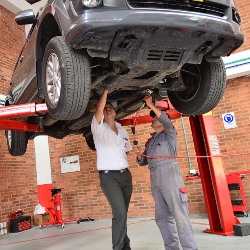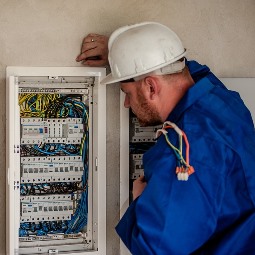How to Enroll in the Right Vocational School near Seneca Michigan
 Deciding to enter into a new profession and enroll in a vocational school near Seneca MI are important decisions that will greatly influence your long term career. However with numerous vocational schools to pick from, exactly how do you approach locating the right one? Not only do you need to make certain that you will get the extensive training required to be successful in your new occupation, but also that the school is highly regarded and reputable. A number of students make the error of choosing a trade school simply because the campus is nearest to their residence or where the work. Others might gravitate to the one that charges the lowest tuition. Of course the cost and location of the programs are important factors when evaluating vocational school options, but they should not be the sole ones. Additional considerations including accreditation and the reputation of the schools are critical also. So before you begin evaluating and comparing trade schools, you will need to know what questions to ask so you can get the information to make a final selection. We will cover a few of those questions shortly in this post. But to start with, let’s talk about a few of the trade options that are offered as well as the availability of online programs.
Deciding to enter into a new profession and enroll in a vocational school near Seneca MI are important decisions that will greatly influence your long term career. However with numerous vocational schools to pick from, exactly how do you approach locating the right one? Not only do you need to make certain that you will get the extensive training required to be successful in your new occupation, but also that the school is highly regarded and reputable. A number of students make the error of choosing a trade school simply because the campus is nearest to their residence or where the work. Others might gravitate to the one that charges the lowest tuition. Of course the cost and location of the programs are important factors when evaluating vocational school options, but they should not be the sole ones. Additional considerations including accreditation and the reputation of the schools are critical also. So before you begin evaluating and comparing trade schools, you will need to know what questions to ask so you can get the information to make a final selection. We will cover a few of those questions shortly in this post. But to start with, let’s talk about a few of the trade options that are offered as well as the availability of online programs.
Trade School Program Options near Seneca MI
 There are a number of professions to choose from in vocational schools that provide gratifying and high paying careers. Possibly you have already chosen one that you have long wished to pursue. For instance, perhaps you have always enjoyed working on your car and have given thought to utilizing that skill to make a living as an auto mechanic. Or perhaps a member of the family has had a long and successful career in a certain vocation or trade and you would love to follow in her or his footsteps. Regardless of what your motivation is for going into a trade, there is undoubtedly a program offered that will give you the training you need. Below is merely a small representation of the vocational training programs that are offered in the Seneca MI area.
There are a number of professions to choose from in vocational schools that provide gratifying and high paying careers. Possibly you have already chosen one that you have long wished to pursue. For instance, perhaps you have always enjoyed working on your car and have given thought to utilizing that skill to make a living as an auto mechanic. Or perhaps a member of the family has had a long and successful career in a certain vocation or trade and you would love to follow in her or his footsteps. Regardless of what your motivation is for going into a trade, there is undoubtedly a program offered that will give you the training you need. Below is merely a small representation of the vocational training programs that are offered in the Seneca MI area.
- Auto Mechanic
- Heating and Cooling (HVAC) Tech
- Plumbing
- Electrical Technician
- Welder
- Truck Driver
- Aircraft Maintenance Tech
- Lab Tech
- Construction Management
Each of the programs will have varying completion times and costs depending on the trade, credential earned and school. Many of the programs may be completed in a few weeks, while others will necessitate several months or even two or more years of training. All of these variables should be considered prior to choosing a trade and a school.
Click Here to Get Free Information on Trade Schools Near You!
Trade Schools Online
 Schools available online have become very popular with Seneca MI students and a growing number of accredited programs are being offered. Although online learning is a readily available and practical way to acquire a degree or certificate, it may not be the best option for all trades or vocations. For example, learning to drive a semi truck is not something that you can do online, nor is training how to weld. These are skills that must be learned through practical training and by doing it, not by studying or watching videos. But certain components of the training may be suitable for online education, for example learning safety and driving regulations for truck driving schools or studying metallurgy or how to read blueprints for welder schools. A number of programs will combine online education with on campus practical training, such as for electrician or welding schools. So it is crucial to find out before enrolling in an online program for any vocation if there is an adequate amount of practical training allocated to the curriculum. One way to help establish est that a trade school program is both suitable for online learning and delivers in-depth hands-on training is to verify that it’s accredited by a nationally recognized accrediting organization (more on accreditation later). For those trades that are appropriate for training online, it can be a practical way for individuals with limited time to learn a new trade.
Schools available online have become very popular with Seneca MI students and a growing number of accredited programs are being offered. Although online learning is a readily available and practical way to acquire a degree or certificate, it may not be the best option for all trades or vocations. For example, learning to drive a semi truck is not something that you can do online, nor is training how to weld. These are skills that must be learned through practical training and by doing it, not by studying or watching videos. But certain components of the training may be suitable for online education, for example learning safety and driving regulations for truck driving schools or studying metallurgy or how to read blueprints for welder schools. A number of programs will combine online education with on campus practical training, such as for electrician or welding schools. So it is crucial to find out before enrolling in an online program for any vocation if there is an adequate amount of practical training allocated to the curriculum. One way to help establish est that a trade school program is both suitable for online learning and delivers in-depth hands-on training is to verify that it’s accredited by a nationally recognized accrediting organization (more on accreditation later). For those trades that are appropriate for training online, it can be a practical way for individuals with limited time to learn a new trade.
Concerns to Ask Vocational Schools
 After you have picked the vocation and type of certificate or degree that you wish to earn, either on campus or online, you can start to narrow down your selection of schools. As you are certainly aware, there are many vocational schools in the Seneca MI area and throughout the United States to select from. That’s why it is extremely important to have a list of relevant qualifiers when making school assessments. As previously mentioned in our opening paragraph, tuition and location will most likely be the initial two factors you will consider. Following are several additional ones that you should explore before enrolling in your school of choice.
After you have picked the vocation and type of certificate or degree that you wish to earn, either on campus or online, you can start to narrow down your selection of schools. As you are certainly aware, there are many vocational schools in the Seneca MI area and throughout the United States to select from. That’s why it is extremely important to have a list of relevant qualifiers when making school assessments. As previously mentioned in our opening paragraph, tuition and location will most likely be the initial two factors you will consider. Following are several additional ones that you should explore before enrolling in your school of choice.
Accreditation. A large number of Seneca MI area technical schools have acquired either a regional or a national accreditation. They can earn Institutional Accreditation, which focuses on the school’s programs overall, or Programmatic Accreditation, which pertains to a specific program, for instance HVAC technology. Make certain that the school is accredited by a U.S. Department of Education recognized accrediting agency, for instance the Accreditation Board for Engineering and Technology. In addition to helping guarantee that you acquire a quality education, it may help in obtaining financial assistance or student loans, which are frequently not available for non-accredited schools. Additionally, a number of states require that the training course be accredited for it to qualify for licensing where applicable.
How Long in Business? One indicator to help determine the quality of a vocational school near Seneca MI is how long it has been in operation. A poorly reviewed or a fly by night school normally will not be in business very long, so longevity is a big plus. However, even the best of schools had to start from their first day of training, so consider it as one of several qualifications.
Completion Rates. Ask the trade schools you are looking at what their completion rates are. The completion rate is the portion or percentage of students who enroll in and finish the course. A lower completion rate could signify that students were dissatisfied with the course and quit. It might also indicate that the teachers were not qualified to train the students. It’s similarly imperative that the schools have high job placement rates. Older and/or more reputable schools may have a more extensive directory of graduates, which can mean more contacts for the school to utilize for their apprenticeship and job placement programs. A high job placement rate can not only validate that the school has an excellent reputation within the trade, but additionally that it has the network of contacts to assist grads acquire apprenticeships or employment in the Seneca MI area.
Apprenticeship Programs. Most trade programs are taught in conjunction with an apprenticeship or an internship program. Those participating trade and vocational programs will help place you in an apprenticeship program within their network of businesses or labor unions. Ask if the schools you are reviewing have working partnerships with Seneca MI area companies in the field. An apprenticeship not only provides a valuable experience by furnishing hands-on training, but it also supplies job opportunities and helps to build relationships in the area professional community.
Modern Facilities. Make certain that the school facilities and the equipment that you will be instructed on are state-of-the-art and what you will be working with on the job. If you are presently in an internship or an apprenticeship, check with the specialist you are working with regarding what you should be looking for. Otherwise, ask a local Seneca MI contracting company if they can provide some tips. Also bear in mind that unless you can move, the school needs to be within driving distance of your residence. Take note that if you decide to enroll in an out-of-state school, besides the added moving costs there can be higher tuition fees compared to in-state residents.
Smaller Classes. It’s important that you receive as much one-on-one instruction as possible, which can be difficult in bigger classes. Ask if you can sit in on some of the classes so that you can see how big they are and witness first hand the interaction between students and instructors. Speak to a few of the students and get their opinions concerning class sizes and instruction. Last, speak to a few of the teachers and find out what their level of experience is in Michigan and what certifications or degrees they hold.
Flexible Scheduling. Verify that the class schedules for the programs you are reviewing are flexible enough to handle your needs. If you can only go to classes at night or on weekends near Seneca MI, check that the programs you are considering offer those options. If you can only attend on a part-time basis, make sure that the school you select allows part-time enrollment. Additionally, check out what the protocol is to make-up classes should you miss any due to work, illness or family emergencies.
Online Technical Schools Seneca Michigan
 Selecting the right trade school near Seneca MI is a crucial first step toward a fulfilling career in the vocation of your choice. As we have discussed in this article, you need to pick a trade school and a certificate or degree program that are both accredited and have exceptional reputations within the trade. Other factors to search for are plenty of practical training and modern facilities. You should visit each of the schools in person that you are most interested in to inspect the campus and talk with both the current students and faculty. Try to get a feel for the quality of the instruction and the interaction between them. In addition, ask about scheduling choices and if night or weekend classes are offered if needed. And remember to ask about financial assistance and student loan options also. You initially came to this website because of your interest in Online Technical Schools and wanting more information on the topic Local Tech Schools. However, if you ask the appropriate questions as we have outlined in our guidelines for assessing schools, you’ll be able to narrow down your choices so that you can make an informed decision. With the proper training, hard work and dedication, you can ultimately become a licensed professional in your chosen trade.
Selecting the right trade school near Seneca MI is a crucial first step toward a fulfilling career in the vocation of your choice. As we have discussed in this article, you need to pick a trade school and a certificate or degree program that are both accredited and have exceptional reputations within the trade. Other factors to search for are plenty of practical training and modern facilities. You should visit each of the schools in person that you are most interested in to inspect the campus and talk with both the current students and faculty. Try to get a feel for the quality of the instruction and the interaction between them. In addition, ask about scheduling choices and if night or weekend classes are offered if needed. And remember to ask about financial assistance and student loan options also. You initially came to this website because of your interest in Online Technical Schools and wanting more information on the topic Local Tech Schools. However, if you ask the appropriate questions as we have outlined in our guidelines for assessing schools, you’ll be able to narrow down your choices so that you can make an informed decision. With the proper training, hard work and dedication, you can ultimately become a licensed professional in your chosen trade.
Other Michigan Hard Working Locations
Piper PA-34 Seneca
The Piper PA-34 Seneca is an American twin-engined light aircraft, produced by Piper Aircraft since 1971 and that remains in production.[4][5][6] The Seneca is primarily used for personal and business flying.[1]
The Seneca was developed as a twin-engined version of the Piper Cherokee Six. The prototype was a Cherokee Six that had wing-mounted engines installed, retaining its nose engine. The prototype was flown as a tri-motor aircraft in the initial stages of the test-flying program.[1]
With the decision to abandon the three-engined design tested on the PA-32-3M, the PA-34 was developed as a twin-engined design. The prototype PA-34-180 Twin Six, registered N3401K first flew on 25 April 1967. The prototype had two 180 hp (134 kW) Lycoming O-360 engines, a fixed nosewheel landing gear and a Cherokee Six vertical tail. The second prototype flew on 30 August 1968, still with the 180 hp (134 kW) Lycomings but had retractable landing gear and a taller vertical tail. During development flying the wingspan was increased by two feet. The third prototype was closer to the production standard and flew on 20 October 1969; it was fitted with 200 hp (149 kW) Lycoming IO-360-A1A engines.[2]
